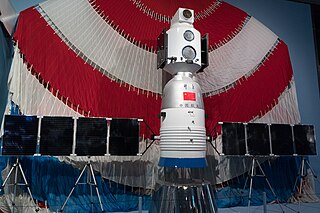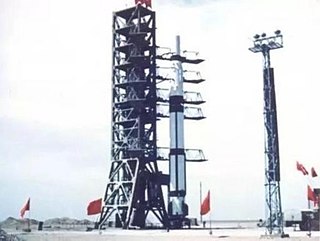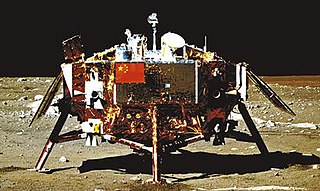The Long March rockets are a family of expendable launch system rockets operated by the China Aerospace Science and Technology Corporation. The rockets are named after the Chinese Red Army's 1934–35 Long March military retreat during the Chinese Civil War.

Shenzhou 5 was the first human spaceflight mission of the Chinese space program, launched on 15 October 2003. The Shenzhou spacecraft was launched on a Long March 2F launch vehicle. There had been four previous flights of uncrewed Shenzhou missions since 1999. China became the third country in the world to have independent human spaceflight capability after the Soviet Union and the United States.

The space program of the People's Republic of China is about the activities in outer space conducted and directed by the People's Republic of China. The roots of the Chinese space program trace back to the 1950s, when, with the help of the newly allied Soviet Union, China began development of its first ballistic missile and rocket programs in response to the perceived American threats. Driven by the successes of Soviet Sputnik 1 and American Explorer 1 satellite launches in 1957 and 1958 respectively, China would launch its first satellite, Dong Fang Hong 1 in April 1970 aboard a Long March 1 rocket, making it the fifth nation to place a satellite in orbit.
As of 2024, the People's Republic of China has sent two women to space: Liu Yang and Wang Yaping, both taikonauts in the People's Liberation Army Astronaut Corps (PLAAC). Liu Yang, China's first female taikonaut, first flew in 2012 aboard Shenzhou 9, and since then three additional missions have included female crew members: Shenzhou 10, 13, and 14. According to the China National Space Administration, many women also hold leadership positions in the Chinese space program, and actively contribute to the Chinese space effort.

The China Aerospace Science and Technology Corporation (CASC) is a main contractor for the Chinese space program. It is state-owned and has subsidiaries which design, develop and manufacture a range of spacecraft, launch vehicles, and ground equipment. It also has a division for strategic and tactical missile systems.

Long March 5, or Changzheng 5 (CZ-5), and also by its nickname "Pang-Wu", is a Chinese heavy-lift launch vehicle developed by the China Academy of Launch Vehicle Technology (CALT). It is the first Chinese launch vehicle designed to use exclusively non-hypergolic liquid propellants. It is the fifth iteration of the Long March rocket family.

The Chinese Lunar Exploration Program, also known as the Chang'e Project after the Chinese Moon goddess Chang'e, is an ongoing series of robotic Moon missions by the China National Space Administration (CNSA). The program encompasses lunar orbiters, landers, rovers and sample return spacecraft, launched using the Long March series of rockets. A human lunar landing component may have been added to the program, after China publicly announced crewed lunar landing plans by the year 2030 during a conference in July 2023.

The Wenchang Space Launch Site is a rocket launch site located in Wenchang on the island of Hainan, in China.

Tiangong-3 was a proposed Chinese space station, part of the Tiangong program. The China National Space Agency (CNSA) was originally expected to launch Tiangong-3 around 2015, following the launch of the Tiangong-2 test laboratory, originally planned for 2013. The goals for the Tiangong-2 and Tiangong-3 laboratories were merged, and the latter was therefore not ordered. The first module of the third station of the Tiangong program, Tiangong space station, was eventually launched in 2021.

Chang'e 2 is a Chinese uncrewed lunar probe that was launched on 1 October 2010. It was a follow-up to the Chang'e 1 lunar probe, which was launched in 2007. Chang'e 2 was part of the first phase of the Chinese Lunar Exploration Program, and conducted research from a 100-km-high lunar orbit in preparation for the December 2013 soft landing by the Chang'e 3 lander and rover. Chang'e 2 was similar in design to Chang'e 1, although it featured some technical improvements, including a more advanced onboard camera. Like its predecessor, the probe was named after Chang'e, an ancient Chinese moon goddess.

Chang'e 3 is a robotic lunar exploration mission operated by the China National Space Administration (CNSA), incorporating a robotic lander and China's first lunar rover. It was launched in December 2013 as part of the second phase of the Chinese Lunar Exploration Program. The mission's chief commander was Ma Xingrui.

Ma Xingrui is a Chinese politician and aerospace engineer who is the Communist Party secretary of Xinjiang. Prior to that, he had served as the Vice Minister of Industry and Information Technology, Head of the Political and Legal Affairs Commission of Guangdong, Communist Party Secretary of Shenzhen, Deputy Party Secretary of Guangdong, and Governor of Guangdong. Ma is a member of the Politburo of the Chinese Communist Party.

Chen Qiufa is a Chinese aerospace engineer and politician of Miao ethnic heritage. He is the Communist Party Secretary and the former Governor of Liaoning province. He formerly served as Director of the China Atomic Energy Authority, Director of the China National Space Administration (CNSA), and Vice-Minister of Industry and Information Technology.

The People's Liberation Army Strategic Support Force was a service branch of the People's Liberation Army that existed from December 2015 to April 2024.
Chang'e 7 is a planned robotic Chinese lunar exploration mission expected to be launched in 2026 to target the lunar south pole. Like its predecessors, the spacecraft is named after the Chinese moon goddess Chang'e. The mission will include an orbiter, a lander, a mini-hopping probe, and a rover.

The International Lunar Research Station (ILRS) (Chinese: 国际月球科研站) is a planned lunar base currently being led by Roscosmos and the China National Space Administration (CNSA). The ILRS will serve as a comprehensive scientific experiment base built on the lunar surface or in lunar orbit that can carry out multi-disciplinary and multi-objective scientific research activities including exploration and utilization, lunar-based observation, basic scientific experiment and technical verification, and long-term autonomous operation. Statements from Roscosmos and CNSA underline that the project will be "open to all interested countries and international partners."

The Planetary Exploration of China, also known as Tianwen, is the robotic interplanetary spaceflight program conducted by the China National Space Administration (CNSA). The program aims to explore planets of the Solar System, starting from Mars, and will be expanded to Jupiter and more in the future.
China Academy of Aerospace Aerodynamics or CAAA is a research and manufacturing organization for rockets, missiles and unmanned aerial vehicles (UAVs). Headquartered in Beijing, China, it is a subsidiary of China Aerospace Science and Technology Corporation (CASC).
The Wenchang Commercial Space Launch Site, located at Wenchang, Hainan, is China's first commercial space launch site, and 5th space launch site. The launch site started construction in July 2022, and is expected to be put into service in 2024.

Long March 10, also known as the “Next Generation crewed launch vehicle”, and previously and unoffically as the “921 rocket” or the "Long March 5G", is a Chinese super-heavy carrier rocket for crewed lunar missions that is currently under development. The nickname "921" refers to the founding date of China's human spaceflight program. In 2022, the first flight of the Long March 10 was targeted for 2027. By January 2024, the first flight's target was moved up to 2025-26.In an April 2024 update, it was announced that program development of the vehicle was complete.
















